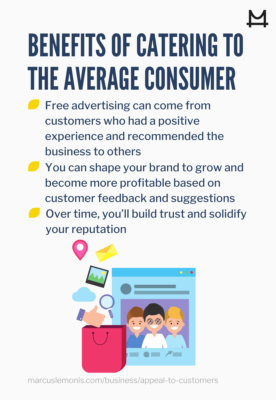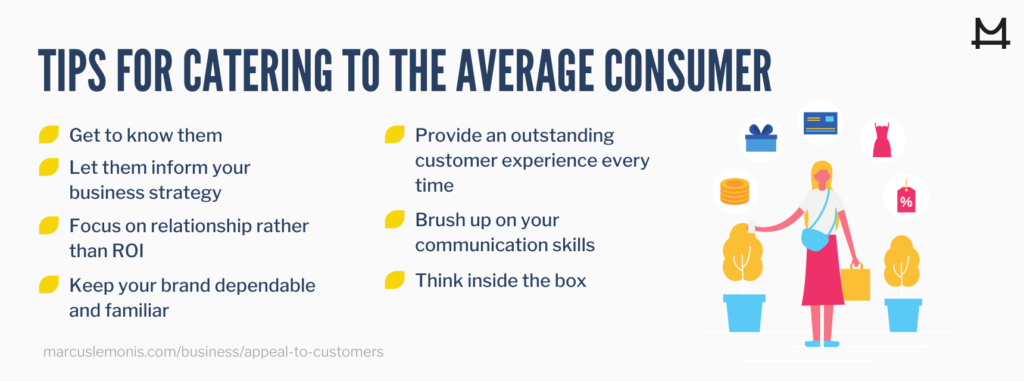
Before Nike launched its wildly successful “Just Do It” campaign in the late ’80s, the brand was targeted to marathon runners. With $800 million in sales, it was trailing Reebok by a growing margin. Dan Wieden, founder of the Wieden and Kennedy ad agency, started thinking about all the average people who wanted to join the fitness craze but just didn’t quite know how to get started. It’s a good thing he did. Ten years later, Nike’s sales exceeded $9.2 billion. Average people on the street, it turned out, weren’t running marathons. They just needed a little inspiration for walking to work or taking the stairs instead of the elevator. They needed empathy, encouragement and a pair of comfortable, hard-working sneakers. Nike has been catering to them ever since.
Does your business cater to average shoppers or to your own idea of the ultimate customer?
The Benefits of Catering to Average Consumers
Yes, there’s the potential to convert average people into paying customers and increase revenue. However, there are other benefits that you may not have thought of. If you provide a dynamite customer experience, free advertising is one of them. Social media is the new word-of-mouth, and average consumers are all over it. According to the Deloitte Consumer Review, 81 percent of consumers read reviews and ratings. One in 3 participate in online forums and comment on other people’s blogs. Seventy-seven percent of customers who have a positive experience tell someone about it and recommend the business. If you can endear yourself and your brand to average consumers, they’ll spread the good word for you. Not only that, but based on their feedback and suggestions, you can shape your brand to grow and become more profitable. Over time, you’ll build trust and solidify your reputation.


Tips for Catering to Average Consumers
1. Get to Know Them
First, you have to know who they are. Getting a feel for that average person on the street goes much deeper than identifying age, income, education and other demographics. It’s about pinpointing their lifestyles and interests. It’s about getting inside their heads and finding out what makes them tick. It’s discovering their emotional triggers, listening when they vent their frustrations, and putting yourself in their place. “Just Do It” was never intended to be a reprimand to the Nike customer. Rather, it’s what the average Joe who doesn’t feel motivated to exercise will say to himself when he laces up a pair of Nikes. It’s relatable. Wieden may have thought of his co-workers, his neighbors or even himself when he suggested the slogan. Curiosity about ordinary people, an “everyman” mindset, so to speak, has yet another huge benefit: It will help you identify all sorts of things that are lacking in people’s lives so that you can provide them. Entrepreneurs thinking about the average person on the street came up with some of the world’s greatest inventions.
One demographic that no business owner should ignore is known as “household enthusiasts.” These are people who live with at least one other person. They do most of the banking, bill paying, budgeting and shopping, and they make the final decision on most purchases for their spouses, partners or children. As reported by Inc. in 2018, a RetailMeNot study found that household enthusiasts generate 15 percent more income than most consumers and spend about 50 percent more than millennials. They’re savvy shoppers who compare prices and are easily swayed by discounts and free shipping. They shop either online or in brick-and-mortar stores close to 10 times per month. The household enthusiast is definitely your friend.

2. Let Them Inform Your Business Strategy
There’s certainly nothing wrong with ambition, personal goals and a strong vision. However, businesses often flounder when owners become hard of hearing where average consumers are concerned. For example, a few years back, Marcus consulted with a California-based toy company. The founder’s two sons had expanded the business, which originally dealt in museum-quality fossil replicas, to include all kinds of games and craft kits. The product line featured toy cars that raced on glow-in-the-dark tracks and an indoor Frisbee golf game made of cardboard.
The toys weren’t exactly flying off the shelves; the brothers were close to $1 million in the red when Marcus showed up. They admitted that the toys hadn’t been tested by consumers and that they carried them because they, the brothers, thought they were cool. Not only did they fail to listen to customer feedback, but they never even invited it. You can see where that got them.

Even Marcus admits that it’s easy to become so enthralled with your own company that you tune out the customers. “I like to romanticize businesses, and I fall in love with them,” he told CNBC in 2016. “But oftentimes, I see people fall in love with their idea. They’ve been reinventing the 8-track cassette tape for 12 years, and they put a lot of time and money in it. And it’s still a bad idea. The best litmus tests for early ideas,” he went on, “are people’s reactions to things.” When you have an idea for a new product or service, bring average consumers into the loop. Have them test it. Ask the right questions, and listen intently to the answers.
3. Focus on Relationships Rather Than ROI
Keep your eye on the prize: loyal, longtime customers. Don’t be so concerned about your own interests or return on investment. ROI is important, but the best ROI results from an investment in people. As Marcus puts it, “Businesses are based on relationships, and relationships are based on people.” This is about much more than making sure transactions go off without a hitch. Modern consumers want meaningful relationships with their favorite brands.

They want ongoing engagement on social media. They like spending their money with business owners whose goals and values align with their own. Mind you, these consumers aren’t necessarily avant-garde thinkers or outspoken activists. They’re those average people on the street that you hope to target. They actively look for brands that support green initiatives, sustainability, employee well-being and social justice. Microsoft, United Parcel Service and Clorox are just a few of the hundreds of companies that have responded. In the process of bettering the environment or being kinder to their workers, they’ve discovered that catering to the average Jane or Joe makes good business sense.
4. Keep Your Brand Dependable and Familiar
Another hindrance to building a loyal customer base is losing sight of brand identity. Business owners sometimes get bored with their own brands. They feel average and want to really stand out. They want to shake things up with a new product line or service that’s creative, controversial or edgy. That’s all well and good if the average consumer can relate, but most can’t and don’t especially want to. They just have a problem that needs solving or a desire for something to make their lives easier. Edgy might work if you want to launch a chain of art house genre theaters, but it will get you nowhere with people seeking a more convenient dry cleaner or pet groomer. Very few, if any, average people wish that someone would come up with more controversial customer service. You want to stand out, of course, but you want to stand out for merchandise that meets needs and provides value. You want to distinguish yourself by treating people well and providing an outstanding customer experience. If you’re already doing that, keep improving and expanding upon what you offer now. Don’t go crazy with all-new products and services until your customers express a need for them. If your brand becomes completely unfamiliar over time, you’ll alienate your biggest fans.

Have you ever watched a long, involved Super Bowl commercial only to realize that the product or advertiser was completely lost on you? That’s what it feels like to walk into a shop or log onto a website that has lost its brand identity. One long established California florist shop is a perfect example. The company had been in operation for many years when Marcus consulted with the owner. The classy florist that had once supplied flowers for major parades and prestigious events was struggling. The store was dirty, neglected and cluttered. Since the founder had passed away, strong, knowledgeable leadership had been lacking. The first thing Marcus noticed was the glaring absence of flowers.
There were plenty of greeting cards, candles and knickknacks, but the average person on the street who went in for a dozen roses would be utterly confused. Marcus’ first order of business was to restore the original brand with the right merchandise — flowers. He shut the shop down for a week to declutter and redesign things so that customers could watch the florists arrange their orders. At the reopening, shoppers raved about the improvements. Sales shot up 30 percent over the previous week.The customers felt at home again.
5. Provide an Outstanding Customer Experience Every Time
More and more consumers are basing their loyalty on customer experience. Product and price still play key roles, but customer experience, or CX for short, is eclipsing them. According to the Econsultancy and Adobe 2020 Annual Digital Trends report, 36 percent of companies that considered themselves advanced in CX exceeded their previous year’s top business goal. Buyers are even willing to pay more for great CX, the survey found. If you’re not providing a consistent, engaging customer journey across all your touchpoints, you’re missing a golden opportunity to expand your customer base and increase your revenue. A PricewaterhouseCoopers survey of 15,000 average consumers was equally eye-opening. One in 3 customers will desert their favorite brands after a single bad experience. More than 90 percent take their business elsewhere after two or three negative incidents.

What are average people on the street looking for in CX? The 15,000 of them who participated in the survey, at least, expect speed, friendly service, convenience, security, and knowledgeable customer support. Don’t worry so much about impressing people with tons of cutting-edge features on your mobile app or website. Pare it down to features that meet needs or enhance the experience. Somewhat surprisingly, consumers admit that they miss the human element. When human interaction isn’t possible, they like technology, such as a chat feature, that mimics it. With CX, you can make a slam dunk nine times out of 10, but that one missed layup could cost you the game.
6. Brush up on Your Communication Skills
Nowadays, there’s no shortage of ways to communicate with average consumers. You can stay in touch the livelong day on social media if you’re so inclined. Email is still a powerful tool, and people still like being able to reach businesses by phone. In all your communications, especially ads, be clear, thorough and accurate. If you arm potential customers with good information, they can navigate the shopping journey independently and buy things. They won’t get frustrated by a lack of details and abandon their shopping carts. To do it right, you must know your product like the back of your hand. Throw in plenty of photos and how-to videos on your website, app and social media pages. Images are powerful communicators too.

When you’re on the phone or speaking in person with a customer, tune out everything else. Be attentive and patient. You might think you could solve everything if the customer would take a breath and give you a chance to talk, but never interrupt. In person, maintain eye contact. Mind your body language. Give signals, such as a nod, to show that you’re listening. Repeat back the gist of the complaint or question: “Let me make sure I understand. You were charged for two cocktails that you didn’t order?” In any communication, above all, be honest and transparent. For instance, don’t gloss over extra costs for add-ons. Don’t promise overnight shipping if it’s more like three-day shipping. Unpleasant surprises are a huge turnoff. If you’re not 100 percent sure about something, say so. Promise to follow up with an answer.

7. Think Inside the Box
There are plenty of opportunities to think outside the box. This is one time to think inside it. As you shift your focus to average consumers, start with the customers you already have. Ask them to participate in a survey of their likes and dislikes. Thank them for their loyalty with rewards or discounts. Be sure to make it personal. That keeps good customers from slipping through the cracks. Let them see your human side through blogs or newsletters. Acknowledge their birthdays. Politely thank them for negative feedback, and resolve issues promptly. Always, always follow up.
As Marcus once said, “Things are always going to go wrong. People make mistakes. I know I do. It’s how you resolve it that matters most. Listen, be open to criticism, resolve it with speed and empathy, and take responsibility.” If you handle them right, even screw ups provide an opportunity to build trust in the relationship.
As long as you make people feel acknowledged, valued and cared for, they’ll forgive just about anything.


- What is your business currently doing to appeal to the average person?
- What can you start doing as a business to better improve/cater to the average person?
Kolowich Cox, L. (n.d.). The 18 best advertisements & ad campaigns of all time. Retrieved from https://blog.hubspot.com/marketing/best-advertisements
Deloitte. (n.d.). The growing power of consumers [PDF file]. Retrieved from https://www2.deloitte.com/content/dam/Deloitte/uk/Documents/consumer-business/consumer-review-8-the-growing-power-of-consumers.pdf
HelpScout.com. (n.d.). 75 customer service facts, quotes & statistics. Retrieved from https://www.helpscout.com/75-customer-service-facts-quotes-statistics/
Roesler, P. (n.d.). RetailMeNot study shows why marketers should target “household enthusiasts”. Retrieved from https://www.inc.com/peter-roesler/retailmenot-study-shows-why-marketers-should-target-household-enthusiasts.html
George, Y. (2019, April 22). The top 33 companies for the environment by industry. Retrieved from https://www.forbes.com/sites/justcapital/2019/04/22/the-top-33-companies-for-the-environment-by-industry/#101e1c396461
Adobe.com. (n.d.). Five marketing highlights from the 2020 digital trends report. Retrieved from https://www.adobe.com/offer/digital-trends-2020.html
PWC.com. (n.d.). Experience is everything. Get it right. Retrieved from https://www.pwc.com/future-of-cx





